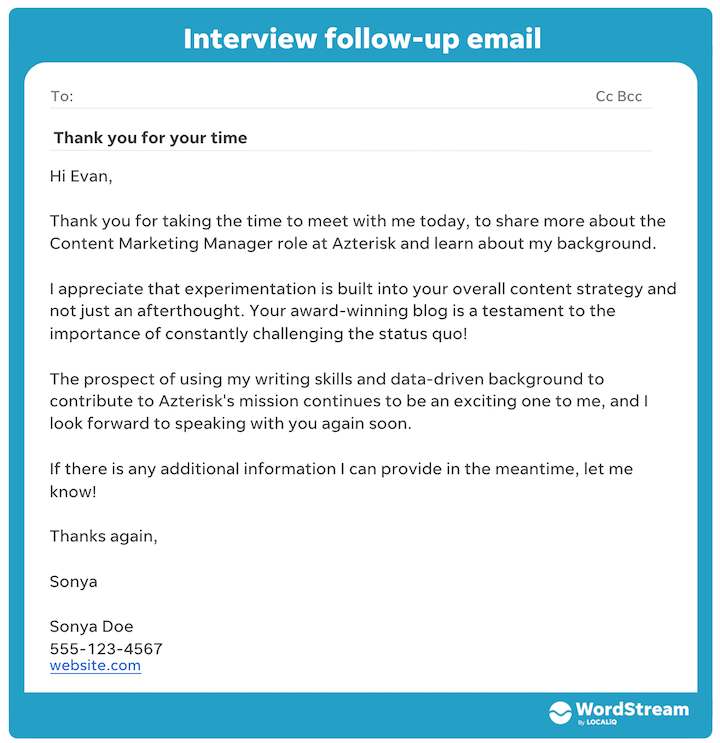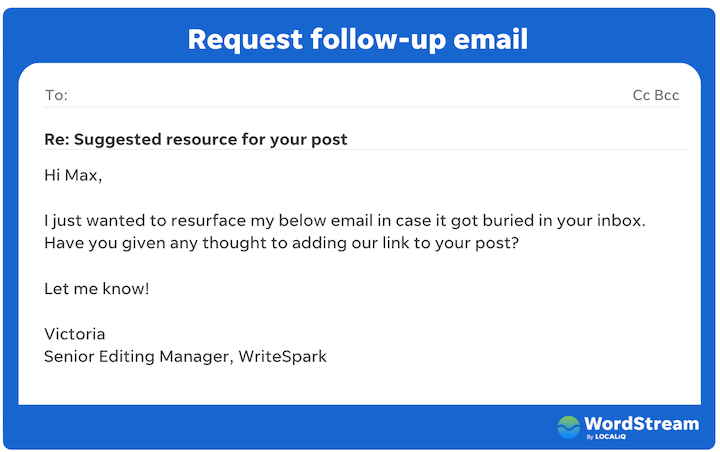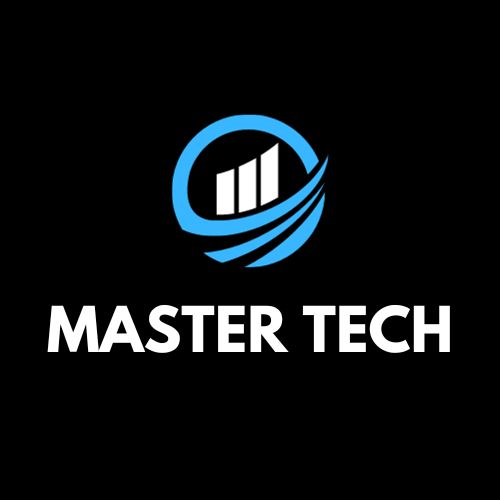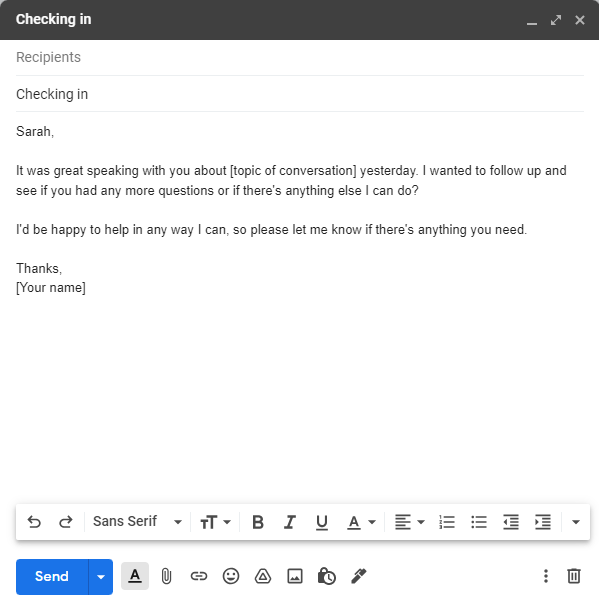Follow-up emails are crucial for effective communication. They can help you stay connected and build relationships.
If you’re looking to improve your follow-up game, you’re in the right place. Crafting the perfect follow-up email can be challenging. You need to strike the right balance between persistence and politeness. Whether you’re following up on a job application, a sales lead, or a business proposal, the right template can make all the difference. In this post, we’ll explore some effective follow-up email templates that you can use to enhance your email strategy. These templates are designed to be simple, efficient, and adaptable to various situations. By the end of this article, you’ll have a better understanding of how to craft follow-up emails that get results. Ready to get started? Let’s dive in! Check out Sender on Appsumo for more tools to enhance your email and SMS marketing campaigns.
Credit: www.hubspot.com
Introduction To Follow Up Emails
Follow up emails are crucial in staying connected with your audience. They show you care and keep your business top of mind. Ignoring follow ups can result in missed opportunities. Following up demonstrates your dedication and professionalism. It helps build stronger relationships with customers. This can lead to increased loyalty and trust.
Follow up emails can significantly boost response rates. They remind recipients to take action. Consistent follow ups can improve engagement. Crafting personalized follow ups can make a big difference. It shows you value their time and interest. Using tools like Sender can simplify the process. Sender combines email and SMS for maximum impact. Automated sequences ensure timely follow ups. This leads to higher conversion rates and better results.
Key Features Of Effective Follow Up Email Templates
Personalized emails stand out. Use the recipient’s name. Mention past interactions. Tailor the message to their needs. This makes the email feel personal. They are more likely to respond. Personalization increases engagement and builds trust.
Timely emails get noticed. Send follow-ups after a few days. Not too soon, not too late. Consider the recipient’s time zone. Sending at the right time boosts open rates. It shows you respect their schedule.
Every follow-up email needs a clear call to action. Tell the recipient exactly what to do. Do you want them to reply? Click a link? Schedule a meeting? Make it simple and direct. This increases the chances they will take action.
Keep your emails short. Stick to the point. Relevant content keeps the reader’s attention. Avoid unnecessary details. Focus on what matters most. This makes it easier for the recipient to read and respond.
The subject line is the first thing they see. Make it attention-grabbing. It should be clear and relevant. A good subject line encourages them to open the email. Use action words and personalize when possible.
Examples Of Follow Up Email Templates
Thank you for your time today. I enjoyed our conversation about your needs. Here’s a brief summary of our discussion and the next steps. Looking forward to our continued collaboration.
Thank you for meeting with us. We discussed key points that are important for your project. Please find attached the summary and action items. Let’s keep the momentum going.
Thank you for the interview opportunity. I am excited about the potential to join your team. Here is a recap of our discussion and my qualifications. I look forward to hearing from you.
Hope all is well. I wanted to follow up on the proposal we sent. Do you have any questions or need further details? We’re eager to move forward and start this project with you.
Just checking in to see if you had a chance to review my previous email. I am here to help with any questions you might have. Looking forward to your response.
Product Information: Sender
Sender is an omnichannel marketing platform designed to enhance email and SMS marketing campaigns. It offers tools for automated marketing, audience segmentation, and seamless integration with popular CMS and ecommerce platforms.
| Main Features | Benefits |
|---|---|
|
|
Pricing Details
Christmas Sale: 40% off all annual plans. Free Plan Available: Get started for free without needing a credit card and cancel anytime.
Customer Endorsements
Trusted by over 180,000 companies worldwide. Positive feedback on quick, helpful customer service and effective newsletter displays.
Contact And Support
24/7 Customer Support: Always available to assist with a high satisfaction rate. Additional resources include a help center, training videos, migration service, and more available for user assistance.

Credit: www.wordstream.com
Pricing And Affordability Of Follow Up Email Tools
Follow up email tools offer various pricing plans to suit different budgets. Affordable options provide essential features for creating effective email templates.
Free Tools: Basic Features For Budget-conscious Users
Free tools provide basic features for users with tight budgets. They usually include essential functions like sending and scheduling emails. Users can also create simple email templates. Some free tools offer limited automation. This can help small businesses or startups. These tools can be a good starting point. They help users learn the basics of email marketing. But, advanced features are often missing.
Premium Tools: Advanced Features For Better Results
Premium tools offer advanced features for better email marketing results. They include automated marketing and audience segmentation. Users can create detailed email campaigns. These tools integrate with popular platforms like WordPress and Shopify. Premium tools also provide excellent customer support. They often have a user-friendly dashboard. This makes managing email campaigns easier. Investing in premium tools can lead to higher conversion rates and better engagement.
Pros And Cons Of Follow Up Email Templates
Follow up email templates can save time and ensure consistency. Yet, they may lack a personal touch. Finding a balance is key.
Pros: Increased Response Rates, Time Efficiency, Personalization
Using follow-up email templates can boost response rates. They save time because you don’t need to write each email from scratch. Templates make it easier to personalize emails, which helps in connecting better with recipients. This can lead to higher engagement and better results.
Cons: Risk Of Being Marked As Spam, Template Fatigue
There’s a risk that your emails might get marked as spam. Overusing templates can cause template fatigue, making your emails less effective. Recipients might recognize the template and ignore the message. Consistent changes and updates to templates are necessary to avoid this issue.
Sender is a powerful omnichannel marketing platform. It enhances email and SMS marketing campaigns with automated marketing, audience segmentation, and integration with popular CMS and ecommerce platforms.
Main Features:
- Combines email and SMS for maximum campaign effectiveness.
- Automated emails, texting, and premade automation sequences.
- Advanced contact management and data-informed segmentation.
- Integrates with WordPress, WooCommerce, Shopify, Zapier, and more.
- 24/7 customer support with quick response times and high satisfaction rate.
Benefits:
- Quick setup leads to rewarding outcomes.
- Targeted messaging increases engagement and sales.
- Simple dashboard consolidates necessary features.
- Easily connects with existing tools to streamline workflow.
Pricing Details:
- Christmas Sale: 40% off all annual plans.
- Free Plan Available: Get started for free without needing a credit card and cancel anytime.
Customer Endorsements:
- Trusted by over 180,000 companies worldwide.
- Positive feedback on quick, helpful customer service and effective newsletter displays.
Contact and Support:
- 24/7 Customer Support: Always available to assist with a high satisfaction rate.
- Help center, training videos, migration service, and more available for user assistance.
Recommendations For Ideal Users And Scenarios
Sales professionals should always send follow-up emails. Timing is crucial. Send an email within 24 hours after a meeting. Personalize your message. Mention specific points discussed. This shows you were attentive. Include a call-to-action. Encourage the recipient to respond or take the next step. Keep it short and clear. No one likes long emails. Follow up regularly, but don’t be annoying. Two to three follow-ups are usually enough.
Thank the interviewer right after the interview. Mention something specific from the conversation. This shows genuine interest. Express your enthusiasm for the role. Reiterate why you’re a good fit. Keep it professional. Avoid casual language. Follow up if you haven’t heard back. Send a polite email after one week. Be patient. Employers may need time to decide.
Send a follow-up within a week after submitting a proposal. Highlight key benefits of your proposal again. This reinforces your value. Ask if they have questions or need more info. Keep it professional and to the point. Show appreciation for their time. Suggest a meeting to discuss further. This can move things forward.
Always be polite. Use a friendly tone. Include a clear subject line. This helps the recipient know the email’s purpose. Summarize the main points from previous interactions. Be concise. Long emails can be overwhelming. Include a call-to-action. This encourages the recipient to respond. Use tools like Sender to automate and track your follow-ups.
For more marketing tools, consider using Sender. It combines email and SMS marketing. Automate your campaigns easily. Segment your audience for better targeting. Integrate with WordPress, Shopify, and more. Enjoy 24/7 support and free templates. Start for free with no credit card needed.

Credit: www.wordstream.com
Frequently Asked Questions
What Is A Follow Up Email?
A follow up email is sent after an initial interaction. It serves to remind, clarify, or provide additional information.
How To Write A Follow Up Email?
To write a follow up email, be clear and concise. Mention the previous interaction and state your purpose directly.
When Should You Send A Follow Up Email?
Send a follow up email within a few days of the initial interaction. Timing can vary based on the context.
Why Are Follow Up Emails Important?
Follow up emails help maintain communication, show professionalism, and increase the likelihood of achieving your goals.
Conclusion
Crafting effective follow-up emails is essential for communication. Using templates can save time. They also ensure consistency in messaging. Remember, the key is personalization and clarity. Tailor each email to your recipient’s needs. For more tools to enhance your email campaigns, consider using Sender on AppSumo. Its features can boost your email and SMS marketing strategies. Try out the free plan to see its benefits firsthand. Good luck with your follow-up emails!

